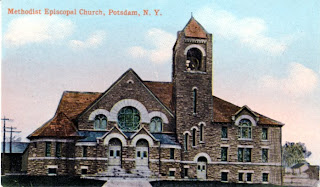Here's a selection of minature postcards from Potsdam, NY. While not particularly uncommon photos, they have the advantage, despite being small, of being in virtually perfect condition due to having been stored in their original packaging for almost a hundred years or so. Unfortunately, though, these are half-tone photo-engravings rather than real photos, or even photo-gravures. Nonetheless, they give us a flavor of what once was. Originally published by H.W. Calkins, who ran a 5-10-25 cent department store at 47 Market St in Potsdam, from 1914 to 1917. The photos are mildly enhanced digitally. Some comments:
District 17 School and the old High School have long since been torn down. I do miss the old Crane Institute. There was always the sound of music coming from its porch and open windows. The old sandstone railroad station was really a neat place when locomotives came through, and then we were reduced to a stinky dinky commuter to Watertown. The RR was Potsdam's major supply and travel link to points south and west when roads were terrible. The steeple on the M.E. church is long gone, but I imagine the one at St. Mary's is still a scary place for a 7-year old, which is how old I was when I was there last. Some of the mill buildings on Fall Island are still there. Has anyone done an architectural study of these, or done some urban archeology on the island? The view from the bridge over the Racquette reminds us that there were buildings on both sides of Water Street, back when there was a Water St. Old Main is still Old Main. It should now be a museum. Perhaps it could house some of the technological accomplishments of Clarkson University's students and faculty. The Fire Department is much improved, but I don't approve of tearing down old stone buildings in the name of progress. Trinity Church is much prettier on the inside. Somebody should make a nice book about it before books become totally obsolete. Somehow the picture of St Mary's got posted twice. When I figure out how to do it, I'll fix that.
North Country Then .... Images from God's Country .... Mostly from the past, some of the present: Jefferson, St. Lawrence, Franklin & Clinton Counties, The Adirondacks & The St. Lawrence River.
Thursday, July 22, 2010
Tuesday, July 20, 2010
Massena Springs
Massena Springs- Is situated on the north shore of the Raquette River, about one mile southeast of Massena village. The St Regis Indians discovered these springs to the government party sent out to survey the ten townships in the summer of 1785. They described them as water coming out of the ground that smelled bad, where the moose, the deer, and the sick Indian came to lick the water. Game of all kinds at an early day were very plentiful in the vicinity of these springs at all seasons of the year, being attracted to the spot, no doubt, on account of the saline qualities of the water. The analysis of the water, showing its constituents, together with other waters, will be found on page 124. The white people began to use the waters of these springs at an early day, and Spafford, in 1813, mentions them as possessing a reputation for the cure of cutaneous complaints, and that invalids came hither from long distances to partake of these waters. In 1822 Capt. John Polley built the first structures for public accommodation. Six years later the old and well known Harrowgate House was erected by Ruel Taylor for Parsons Taylor. Numerous private dwellings soon followed, and the springs were improved by curbing and a pavilion, also hot and cold shower baths erected. In 1848 Benjamin Phillips became proprietor of the springs, and erected what was long known as the United States Hotel, and which was very popular. This was burned in 1871, and on its site was erected the splendid Hatfield House, at a cost of $75,000. Besides this the Harrowgate House is now kept by W. R. Stearns, who also has charge of the waters of the springs. In addition to these houses the Wheeler is kept by Alonzo Riley, a well conducted and popular house. There are two stores at the Springs, and through the growth of the place and of Massena village the two have become substantially one. While the popularity and reputation of these waters has not, perhaps, declined, there has in very recent years been a less number of visitors to the place than formerly a fact which is creditable almost wholly to the strong opposition at various summer resorts, such as the Thousand Islands, in the Adirondacks, and elsewhere. - Gates Curtis. Our County and Its People. A Memorial Record of St. Lawrence County. New York: The Boston History Company, 1894. 19th Century Stereoscopic View. Personal Collection.
Wednesday, July 14, 2010
Sara Cole, Photographer, Parishville, NY
Beloved spouse and I were recently guests of Sara’s parents where God’s Country is up close and personal. They proudly showed me this great photo of an eagle spreading its wings. This was taken by Sara with a long lens from a canoe, along with some 80 other eagle portraits. Sara’s been shooting birds and people for a some time, not always from a canoe, but always with a camera. Fifty years ago we didn’t have any eagles in this location. Now we have many. Life is good in God’s Country. Photo copyright 2010 by Sara Cole.
Subscribe to:
Posts (Atom)











